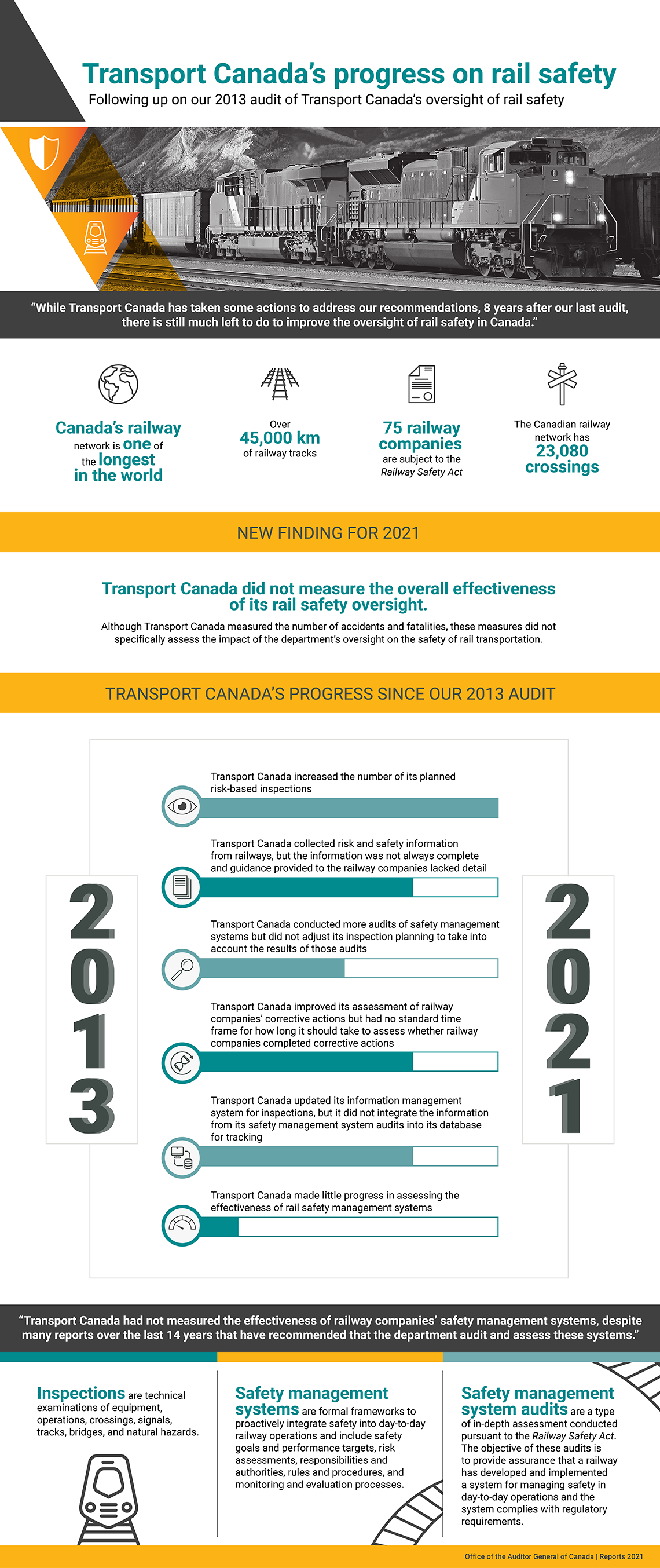Report 5—Follow-up Audit on Rail Safety—Infographic

Text version
This infographic presents findings from the follow-up audit on Transport Canada’s progress on rail safety. This audit followed up on our 2013 audit of Transport Canada’s oversight of rail safety.
Two overall messages from our 2021 audit
- While Transport Canada has taken some actions to address our recommendations, 8 years after our last audit, there is still much left to do to improve the oversight of rail safety in Canada.
- Transport Canada had not measured the effectiveness of railway companies’ safety management systems, despite many reports over the last 14 years that recommended that the department audit and assess these systems.
About Canada’s railway network
- Canada’s railway network is one of the longest in the world.
- The railway network has more than 45,000 kilometres of railway tracks.
- 75 railway companies are subject to the Railway Safety Act.
- The Canadian railway network has 23,080 crossings.
New finding for 2021
- Transport Canada did not measure the overall effectiveness of its rail safety oversight. Although Transport Canada measured the number of accidents and fatalities, these measures did not specifically assess the impact of the department’s oversight on the safety of rail transportation.
First overall message: Transport Canada’s progress since our 2013 audit
While Transport Canada has taken some actions to address our recommendations, 8 years after our last audit, there is still much left to do to improve the oversight of rail safety in Canada.
From 2013 to 2021, we assessed Transport Canada’s progress as satisfactory in the following 4 areas:
- Transport Canada increased the number of its planned risk-based inspections, fully addressing our 2013 recommendation for this area.
- Transport Canada collected risk and safety information from railway companies, but the information was not always complete and guidance provided to the railway companies lacked detail. While the department has made good progress, more work is needed to fully address our 2013 recommendation.
- Transport Canada improved its assessment of railway companies’ corrective actions but had no standard time frame for how long it should take to assess whether railway companies completed corrective actions. While the department has made good progress, more work is needed to fully address our 2013 recommendation.
- Transport Canada updated its information management system for inspections, but it did not integrate the information from its safety management system audits into its database for tracking. While the department has made good progress, more work is needed to fully address our 2013 recommendation.
From 2013 to 2021, we assessed Transport Canada’s progress as unsatisfactory in the following 2 areas:
- Transport Canada conducted more audits of safety management systems but did not adjust its inspection planning to take into account the results of those audits.
- Transport Canada made little progress in assessing the effectiveness of railway safety management systems.
Second overall message: Effectiveness of safety management systems
Transport Canada had not measured the effectiveness of railway companies’ safety management systems, despite many reports over the last 14 years that have recommended that the department audit and assess these systems.
About inspections, safety management systems, and audits of those systems
Inspections are technical examinations of equipment, operations, crossings, signals, tracks, bridges, and natural hazards.
Safety management systems are formal frameworks to proactively integrate safety into day-to-day railway operations and include safety goals and performance targets, risk assessments, responsibilities and authorities, rules and procedures, and monitoring and evaluation processes.
Safety management system audits are types of in-depth assessments conducted pursuant to the Railway Safety Act. The objective of these audits is to provide assurance that a railway has developed and implemented a system for managing safety in day-to-day operations and the system complies with regulatory requirements.